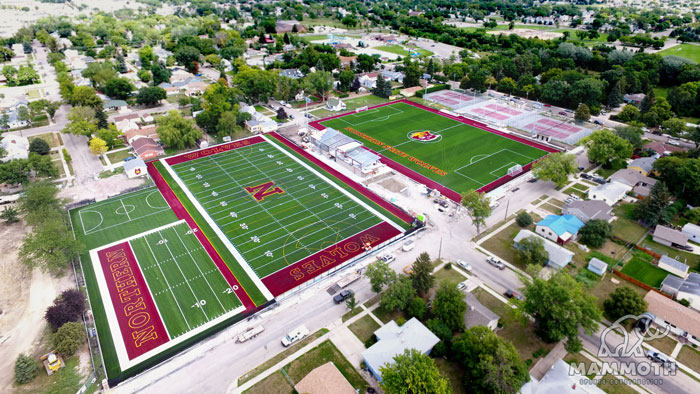Sports field manufacturers and designers strive to find the balance between durable, versatile and cost-effective multipurpose surfaces that also provide maximum player performance, while at the same time minimizing injuries. Such are the expectations of pro team owners, educational institutions and park officials, whose sports fields must accommodate not only frequent athletic play, but also occasional concerts and special events such as convocations. Besides cost, safety, durability and flexibility are major drivers of sports field surface and design innovations.
And while many athletes may prefer natural grass fields for football, baseball, soccer and many other games, heavy usage on such fields has led many sports field owners and managers to turn to synthetic field products.
“Before 2003-4, when I started introducing the technology to school facility management and parks district management, artificial turf was primarily relegated to university campuses and professional sports facilities in the south,” said Pat Underhill, CEO, president of UDC Sports, a Statesville, N.C., sports facility construction and design company. “From Virginia and Tennessee south, we’ve grown sports field grass pretty easily down here. The market for turf was more in the north, or colder climates, where the growing season is shorter, or in Texas, where they have less rain and lots more money.”
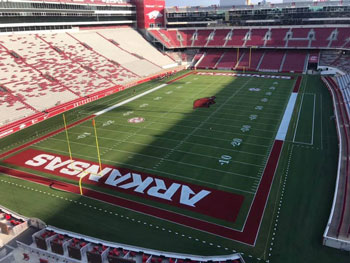
But as fields have seen more usage from a diverse array of sports and teams, synthetic turf has made gains. Forty years ago in high schools, you’d often find a field that was used for varsity and junior varsity football. That field largely didn’t get touched for eight months out of the year. Then soccer was introduced and now the same field might be used for men’s and women’s soccer and other sports, too. “That’s a lot of pressure on a single grass field, even if you have someone that is a professional turfgrass expert on hand,” Underhill said. “When you had a hard rain Thursday, the underlying soil would be soggy. Playing a Friday night football game on that surface trashed it for the rest of the season, which means uneven play on the surface. That is hazardous, with bare spots where you have exposed areas. To maintain these fields in a consistently playable condition was a real challenge. Those factors have driven the trend toward using artificial grass to give a more consistently safe and playable surface.”
“Almost every high school field we design now will have a synthetic field, at least one, if not an entire athletic field complex,” explained Arash Izadi, director of sports and recreation for LPA, an integrated design firm with six locations in California and Texas. Izadi has designed more than 15 million square feet of synthetic turf around the country. “What dictates its installation is the demand of our clients. People want synthetic turf for a variety of reasons, including the expectation of longevity.”
It’s taken half a century to get to where synthetic turf manufacturers, field installers and natural grass growers are today. Consider how far the industry has come from the first installation of synthetic turf at a major sports stadium in 1966, inside the Houston Astrodome. That turf was initially marketed under the name ChemGrass, a short, fiber-dense nylon carpet produced and marketed by Monsanto.
There has been considerable change from the old carpet-over-concrete used in the 1960s, said Darren Gill, vice president of a Montreal-based field turf manufacturer. “It was really revolutionized by our company, which introduced this new turf, long blades of grass, fake grass and a mixture of infill materials, which started off as sand and rubber.”
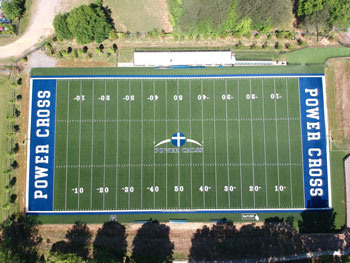
At the Astrodome, the carpet was laid over a compacted soil base. By the end of the 1966 season, ChemGrass was renamed Astroturf. “Astroturf was a knit product back in the day,” Izadi said, “and there is still a version of it for their field hockey system. It was concrete with the turf on it. But when people fell on it, they’d get all sorts of injuries. It got a bad rap. The company needed to come up with an alternative because grass didn’t grow inside the Astrodome. That turf went away, and it became an infill system, where they tried to mimic what natural grass does. There were blades of grass with stuff in between, which gave it attenuation. The main systems were sand, or some kind of rubber to give it balance.”
Manufacturers came up with these systems and started installing them across the country. “The original systems were called ‘slit film,’” Izadi explained. “Slit film was designed to shred a little bit and look like grass. Those started to wear out, so manufacturers wondered how to make synthetics a little bit better.”
The next step in the evolution of synthetic turf was monofilament turf fibers, singular blades that are typically thinner than slit film blades and stand up straighter than slit film surfaces. “This monofilament surface is great for ball rolls,” Izadi said. “And visually it looks great. If you are ever in a stand and look down on a field or watching a game on TV and the field looks shiny, it is probably a slit film field. If it looks perfect, it’s probably a monofilament field.
“We select a surface based on the sports that are being played on it, and the usage,” Izadi explained. “Rugby is awful on any field, with the scrums that they do. When you look at a soccer field, the sideline areas get worn really bad. In football, it’s right down the middle where you get a lot of wear and tear. Baseball and softball are their own little animals.”
The Onset of Infill
Once manufacturers got their turf fiber figured out, there was much discussion about infills. Rubber is resilient and does many things well, but there is a stigma in some areas, including a regional concern in Washington state about playing on artificial turf and cancer clusters. Studies have investigated the risk. One prominent example is a 2017 investigation by the Washington State Department of Health, which concluded that “the currently available research on the health effects of artificial turf does not suggest that artificial turf presents a significant public health risk. The Washington State Department of Health recommends that people who enjoy soccer continue to play irrespective of the type of field surface. The Washington State Department of Health will continue to monitor new research that emerges on the health and environmental impacts of crumb rubber.” 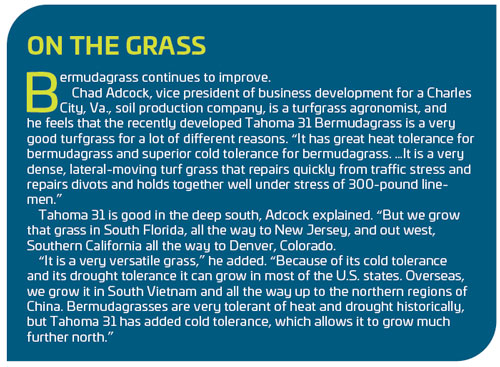
“There are hundreds of infill types,” Izadi said. “Many are much cooler than rubber fields, but some don’t have the resiliency you get with rubber. In some cases, even though it is a synthetic field, you have to irrigate it, put water on it, keep it wet—otherwise it blows away in the wind. Generally, these newer fields perform well in both warm and cooler weather. Even in the south, a field can be 10 to 15 degrees cooler, depending on which filler you use.”
“The big trend today,” Gill said, “are a multitude of alternative infills that are different from crumb rubber, which had been the incumbent for years. But one of the trends today is wider offerings—a drive to have alternate infills.”
For example, some byproducts of food manufacturing can be turned into infill, including coconut husks, vegetable byproducts, cork and walnut shells. “You name it,” Gill said. “Even wood chips. There are a large variety of infills in the organic category. That segment is the one growing the fastest, with more natural products. The most popular is cork, a wood-based product.”
Testing for Safety
Safety at all levels of play is a concern, and especially the risk for concussions. Ironically, player-to-surface contact isn’t the main issue, Izadi said. “It is certainly a contributor, but player-to-player contact is much more prevalent than player-to-surface contact. So, how do we make the fields safe? There are studies that compare synthetic turf to pristine natural turf,” but most facilities don’t maintain their “natural grass fields at that level of care. They don’t have a groundskeeper” to keep up with regular maintenance requirements to keep that field in peak playing condition.
To test for safety, a commonly used protocol is GMAX, which measures the shock attenuation performance of a sports surface, with standards recommended by the Synthetic Turf Council and ASTM. The higher the GMAX of a playing surface, the harder, and more dangerous, it is. A GMAX of 200 or more is considered to be dangerous for athletes. In fact, industry standards specify that synthetic turf fields should stay at, or below, a GMAX of 165. The hardness of an athletic field is crucial to safety.
However, the thinking among many manufacturers is that GMAX might not be the best test. “You have the HIC, head injury criteria, that has come out of the playground industry,” Izadi said. “Some feel it is a much better way to measure the safety of a field. There is a tendency to want to make a field really soft, but if you make a field too soft, it would be like running on beach sand and you can get more lower body injuries, such as ACLs. When you have that movement, what is your weakest link? That is what is going to break. You don’t want a field to be too soft or too hard.”
HIC measures different aspects of everything from how a surface conforms to how it bounces back, or energy restitution. Measuring it is a trend that many manufacturers are starting to look at. They are looking at the integration of a shock layer underneath the turf carpet.
“We adopted a league-wide testing program for Major League Soccer (MLS) this past year,” said Jared Minnick, grass consultant, director of the Maryland SoccerPlex, and a consultant for MLS and European soccer giants Barcelona and PSG. “Understanding the player-surface interaction, or player experience, whether it is on natural grass or synthetic turf is the most exciting development in research, and will help us improve all surfaces for these athletes. Because we are now to the point where we are not guessing.
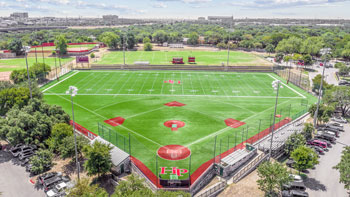
“We were pretty good at guessing,” Minnick added. “We had years of intuition and experience that go into a lot of field management programs. But data has completely changed what we are doing. We can make the correct decision, and it has reduced the complicated nature of managing a natural grass field. Now, we focus on the high-traffic areas. We do less to the corners, more to the middle where the traffic pattern shows. That makes money go a lot further. And makes the field last a lot longer,” Minnick said.
Research from the University of Georgia about injuries on intramural fields revealed that noncontact injuries were happening most often in the transition area of a field, where it went from hard in the middle to soft on the outside, because it doesn’t have foot traffic. Or from wet to dry because of the different compaction levels from actual water. More than 60% of those noncontact injuries were happening in those transition areas where a field isn’t consistent.
Data-Driven
Data is driving many differences in playing surfaces, especially when it comes to how synthetic turf is used for different sports. There are some pretty big differences.
For example, a surface infilled all with rubber might be measured by how much the surface is deformed under the foot—“Essentially, how squishy the surface is.,” Minnick said.
American football is not suited for a surface that is over a certain deformation, because it is essentially too squishy or too spongy, Minnick explained. “They want a little more firmness. It can be firm on the surface, but soft, or not hard overall. The entire root zone of a synthetic or grass field can be soft, where energy can be absorbed, while the surface can be firm. Football likes it firm, to have it a little bit more true footing. But in football, they are pushing and driving off the surface. They are not running six-and-a- half miles like soccer players during a soccer match. The physical impact of a harder surface doesn’t impact the player because they are not running as much, whereas soccer players like the field a bit more squishy, if you will.
“I have never gotten any feedback from field hockey coaches about footing,” Minnick said. “Field managers care about the ball rolling and don’t seem to think about other things they can care about. We encourage coaches and players to tell us everything going on in their minds so we can try and answer those questions. We try to provide solutions to answer challenges and make it the best possible surface we can for users.”
Product Life
“When you look at the life of a system there are two components,” Gill explained. “One is the turf carpet, or the fiber, and that is what usually wears out the quickest. Anything made of plastic that is outside breaks down naturally through degradation and wear. The infills will outlast the carpet, but the real question about some of those alternatives is: How long will they last on their own?
“Most sand and rubber systems, those infills, when the field is removed they can be reused because they are not degrading as much as the turf carpet. We don’t really know, on the organic side, if that is going to be the same story,” Gill noted. “I don’t believe to date that there is an organic field that has been reused a second time, whereas there are a multitude of sand and rubber installations that have been reused. There are some questions about the longevity of organic infills versus your typical sand and rubber infill systems.”
Maintenance Misconceptions
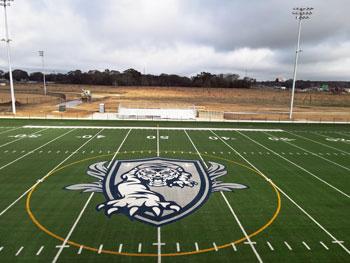
There are misconceptions about maintenance of synthetic turf. Some people believe that once you install synthetic you won’t have to do anything to it, but that’s not true. Excessive use on any system dictates more maintenance. The big difference is that when you look at maintenance of synthetic fields, you only have to maintain it based on use, said Minnick. “If you don’t use it, there is not much to do. That is the biggest difference. Synthetic turf is purely driven by use, versus natural grass, which is driven by just the fact that it is there.
“With a natural grass field, you are irrigating it all the time, or else it dies. You have to mow it, add fertilizers and aerate it, depending on where you are. In northern states you are using bluegrass, in the southern states, bermudagrass. All of these have dormancy periods, so you are usually transitioning at one point in the year and seeding the other times of the year. It is a living, breathing thing. You have to let it rest and recover and transition.
“Synthetic fields you can use 24/7, and it can last 10 to 15 years, depending on the system you have. You will have to sweep it, vacuum, and groom it. The maintenance really is lower.”
Design Trends
Space utilization is the predominant trend in design. “As space becomes a premium,” Gill said, “we are seeing more fields that have a multitude of sports on them. What is not uncommon now is that you would see a recreation area that has a baseball field, a soccer field, and a football field combined into one area. We are finding ways to use that space, especially spaces that are a little more landlocked.”
Designers are finding more ways to use their space and realizing that because of the high usage, you can find more ways to be creative in how you use the field. The days of single-use sports fields have gone by the wayside.
Community events, whether big parties or convocations, are being staged on fields where people can meet and gather, Gill said. “Make those spaces as useful as possible. That helps in telling the story on why synthetics are the most efficient use of taxpayer dollars versus the natural grass surface, which can’t maintain that same sort of durability given how much usage these fields are getting.”
Gill’s company produces hybrid grass—natural grass combined with synthetic fibers or grown around synthetic membranes. It has the benefits of grass, which people like, Gill explained. “And it helps create a stronger bond in the grass, making it more durable.”
Durability means more coverage and the athlete can do what they need to do, which is cut and get the best footing on the grass versus a sparser surface.
Some stadiums are bringing in light systems to create a kind of synthetic sun to help the grass grow. But maintenance of hybrid grass is about the same as regular grass surfaces, Gill said.
Looking Ahead
In the future, Underhill believes, “manufacturers and designers will continue to correct issues that are somewhat problematic in the application of the product. One issue occurs especially in the South, where we have been a late adapter to artificial turf. The surface temperature is a challenge, so we are addressing heat reduction in the industry, whether through the use of various infills or fiber technology. There will also continue to be improvements in trying to better understand the interaction between athletic footwear, athletic movement and surface.”
Lastly, Underhill said, there is the question of what to do at the end of the useful life of the system. “The industry is just now getting serious about that question,” he said. “Do you repurpose a synthetic carpet, or reuse it? Some companies are offering recycling on a limited basis. That is going to be a growing trend—facility owners and municipalities requiring contractors to show that they have done everything they can to not put this material in a landfill when it is time to replace the surface. It’s a problem. There have been several documented instances of illegal dumping in Pennsylvania. RM



